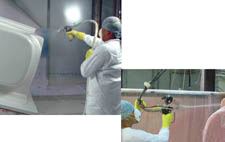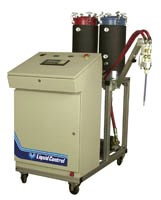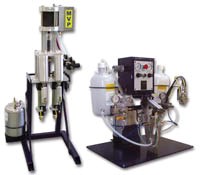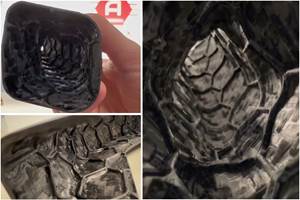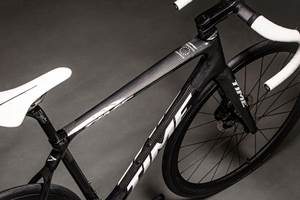Meter, Mix Dispense Update
New technologies are improving accuracy, ease of use and repeatability while moving toward automation.
The metering, mixing and dispensing of fluid materials has always been a crucial part of the composites production process. As composites manufacturers embrace closed molding, processes that automate molding functions are ever more critical. Mechanical mixing of multi-component resins for adhesives and laminating matrices not only speeds production but, more importantly, improves proportional accuracy, a key to optimizing a resin's properties and the resulting finished part's performance. Likewise, dispensing accuracy is a key to optimizing material usage. Meter/mix/dispense systems can reduce waste and therefore aid in profit realization. While the basic technologies used in today's equipment are well established (overviewed in "A Roundup of Meter/Mix/Dispense Equipment," CT February 2002, p. 12), recent refinements of or variations on these technologies, including the introduction of computer-based controls, have done much to improve system accuracy, reliability and ease of use.
SYSTEMS FOR ALL SEASONS
Among the most significant innovations are computer- and microprocessor-based controls. Several equipment manufacturers (noted below) offer controllers with LCD interfaces, which enable operators to set and monitor, in real time, the dispense time, flow rate and mix ratio. Programs for machine settings can be created, saved and recalled for later use. This permits adjustments to be made more readily, based on environmental changes on the shop floor. David Mandeville, Sealant Equipment & Engineering's director of marketing, notes that programmability enables manufacturers to change cure time, eliminate off-ratio start up and develop seasonal programs that account for temperature- and-humidity-related changes in resin viscosity. According to Mandeville, future systems will be able to automatically account for and adjust to changing environmental conditions, yielding the right mix every time without continuous operator intervention. In addition, this type of controls provide the key to integrating meter, mix and dispense systems into automated composite production lines.
Today, the market for meter/mix/dispense systems can be divided into three main categories. Two are well established: equipment designed for use with spray technologies and systems designed for adhesive application. A third and much newer segment comprises meter/mix technologies used to supply resins in vacuum infusion, resin transfer molding (RTM) and other closed-molding applications as well as automated cast polymer applications. Although meter/mix/dispense systems in these categories have somewhat different goals, the equipment used in each is similar. Therefore, most companies offer systems adapted for all three segments, though each may specialize in equipment for one category.
CLOSED MOLDING & MORE
In recent years, the largest growth in the meter/mix/dispense market has been in closed molding. Lynn Sours, general manager of GS Manufacturing (Costa Mesa, Calif.), notes that these areas have a greater potential for growth due to MACT-mandated emission thresholds and various developments that have reduced closed mold tooling and production costs. For example, mixing systems that, early on, were located remotely from closed molds and connected via hoses or piping have been redesigned to permit mixing of resin components just prior to resin introduction into the mold. This has vastly reduced the labor, solvent usage and resin waste associated with system cleanup. Once confined to the larger, volume production shops, these systems also have found a place in smaller operations. "Most equipment suppliers, including GS, now have entry-level systems for smaller shops and R&D, while also offering tooling consulting and hardware on dispensing systems with PC monitoring capabilities," says Sours. GS introduced its new line of low-cost RTM equipment at the just concluded ACMA show in Columbus. The GS approach is to keep equipment simple and cost-effective, only adding options to equipment when needed.
In 2004, Magnum Venus Products (MVP, Clearwater, Fla.) introduced its Mini Link Metering System, used for precise low-volume delivery of urethane and epoxy for RTM and other closed molding process, including pultrusion. (MVP demonstrated the metering accuracy of the Mini Link's displacement pumps at a recent trade event by using it to mix vodka and orange juice to make screwdrivers of ideal ratios!) Depending on output requirements, the Mini Link offers resin/catalyst ratio adjustment between 1:1 and 15:1. As part of the Mini Link system, MVP has designed the LoPro 1:1 Gun that offers both manual and automatic application and a two-sided flush for easy cleaning with minimal solvent use.
Liquid Control (N. Canton, Ohio) has released the DL, a plural-component, continuous flow epoxy resin dispensing machine capable of metering material at rates up to 1.5 gal/min through a static mixer, with an accuracy of ±1 percent. The DL can be equipped with either gear pumps or progressive-cavity pumps and offers continuous ratio adjustment from 1:1 to 5:1. The former are used for applications without fillers. The latter are employed when abrasive fillers are added, since fillers tend to bind gears and bearings. The company can customize most machine components to meet customer needs.
The DL is controlled by Programmable Logic Control (PLC) software. A display screen with icons assists operators with configuration, setup and operation. The system also offers password protection to discourage accidental or unauthorized program changes. The DL can be combined with the company's internally recirculating Parastat static mixing head for use in VARTM production lines. The DL also can be adapted for pourable elastomers and epoxies, filament winding and open or closed mold pouring.
Sealant Equipment & Engineering (Plymouth, Mich.) recently added the Servo-Flo 105 to its line of Servo-Flo two-component meter, mix and dispense systems. "These systems use positive-rod displacement cylinders and servo-motors to meter material, which gives the operator direct control of the material being dispensed into the mold," says Mandeville. He contends that systems that depend on air or oil displacement motors offer only indirect control, and are dependent for their metering accuracy on the pressure stability. Servo-motors and metering rods, by contrast, directly displace the material, improving volume monitoring and handling ease, he says. Further, each component has its own servo-motor, so these systems reportedly enable continuously variable ratio adjustment while delivering up to 2 gal/min (7.2 l/min).
Aplicator System AB (Molnlycke, Sweden) has developed the VRI-515 machine for vacuum infusion by combining the flow control unit from its VIM-5 machine with the precision metering system from its RI-15 machine. The VRI-515 allows for multiple vacuum infusion ports, each of which can be individually controlled during the infusion process. The VRI-515 machine uses pneumatic, dual-acting piston pumps. To avoid potential variation in the mix ratio, the catalyst pump is mechanically synchronized with the resin pump. This "slave" system assures that the correct ratio is maintained, regardless of variations in air pressure or resin viscosity. The dispensing capacity can be 60 kg/min or more, depending on the number of vacuum hoses used and the machine settings. This machine is equipped with an automatic dispensing head that accommodates a static mixer and features internal recirculation, and has a continuously variable slave catalyst pump (0.8 percent and 4.0 percent) and a wheeled chassis for full mobility.
In the cast polymer market, automated systems have been available to high-volume/large part manufacturers for some time, but their expense and size often prohibited use in smaller shops. Respecta Maschinenbau GmbH (Wulfrath, Germany) has introduced the Eco and the VacuCast Eco, smaller versions of its DB line of continuous multi-component meter/mix/dispense systems. Each system in the DB line is custom-designed to meet a customer's specific needs, though each typically includes systems for heating resin, introducing accelerator and dispersing pigment and filler. Filler components loaded into hoppers on top of the DB machine are metered through a screw conveyor into a mixing chamber. The system is adaptable for polypropylene, polyurethane, polyester and acrylic resin systems. DB machines are capable of delivering mixed material at rates from as low as 15 lb/min (6.8 kg/min) to as high as 200 lb/min (90.7 kg/min).
According to Gary Perry, Respecta's North America sales representative, the smaller, less expensive machines offer the same features on a smaller scale and are often used for smaller molds or in lab settings where dispense rates are below 8 lb/min (3.6 kg/min). The Eco and VacuCast Eco bring the DB's continuous metering, mixing and dispensing capabilities to shops where multiple batches of material had to be mixed separately and combined to fill large molds. In sharp contrast to batch preparation, the continuous systems require little labor. At cleanup, the quantity of mixed material that remains in the machine is less than 1l (1 qt), reducing material waste and solvent usage.
Perry says Respecta's machines provide cast polymer manufacturers in technologically advanced countries a way to compete with manufacturers in developing economies where workers are willing to mix and apply materials by hand for substantially lower wages.
SPRAY UP KEEPS UP
In the spray equipment arena, GlasCraft's (Indianapolis, Ind.) director of sales and marketing Mike Keegan reports, " All manufacturers are focusing on the same issue — emissions — and anything that reduces emissions is a positive for everyone." Most manufacturers have developed what are termed nonatomized resin applicators. This change has been driven by the requirements of EPA's maximum achievable control technology (MACT) and various state agency rules for reducing environmentally harmful emissions.
GS Manufacturing's Sours points out that the term "nonatomized" is actually a misnomer. The guns atomize the mixture, but emit a spray pattern characterized by much larger droplet size than traditional "atomized" sprays. Droplet size is important because as the size increases so does surface area and mass. Gravity acts more quickly upon it and evaporation is reduced. The spray also is less likely to mist and linger in the air, making it easier to contain also reducing harmful emissions. The spray pattern is easier to control as well, reducing waste from overspray. Reducing the system pressure has been a key component to this increase in droplet size. It can be postulated that the ideal droplet size would be a large continuous flow out of a hose; however this is often considered impractical in a production environment. Thus, the focus of most equipment suppliers has been to find a balance point between lower emissions and workability. The balance has been hard to find. In fact, a Statement of Findings (SCAQMD No. 050316JK) recently published by the South Coast Air Quality Management District (SCAQMD) recommended a reversal of its nonatomizing requirement: "Since the expected emissions reductions from nonatomizing gel coat application techniques are infeasible, rescinding implementation of the nonatomizing requirement does not burden gel coat operators with installing techniques without environmental benefit." This finding was adopted and Rule 1162 - Polyester Resin Operations was amended (see the notice on SCAMQD's Web site).
The "atomization" controversy not withstanding, several meter/mix purveyors have recently made improvements that reduce emissions, improve workability and reduce material usage.
MVP has introduced the displacement pump-activated Duo Link for meter/mix spray delivery of urethane coating, adhesive, and laminating materials specifically for a 1:1 ratio. Combining this system with MVP's patented FIT (Fluid Impingement Technology) reduces the need for the wasteful secondary process of hand rolling air pockets out of wet laminate after spray application. MVP is continuing development to apply both the Mini and Duo Link to filament winding applications. These systems are still being tested and MVP is expecting a product launch in the coming months.
Aplicator has continued to develop systems for gel coating. The new, more compact version of the company's MIPG-24/HV uses air-driven, dual-acting piston pumps where the stainless steel catalyst pump is synchronized with the gel coat pump shaft. Catalyst volumes are easily adjusted by means of a hand wheel, which changes the stroke length of the pump. The mixing ratios are continuously variable. Components are then mixed in a static mixer within the spray gun. An automated flush system enables easy changes in color. For degassing and testing, the machine is also equipped with a unique gel coat and catalyst recirculation system. Degassing is helpful because it removes air bubbles within the gel coat resulting in a more uniform product being sprayed. The recirculation system allows the material to mix more therefore removing more air bubbles and adding the benefit of degassing to the system.
In addition, Aplicator has developed a robotic gel coat system for an automated process of producing preforms for RTM applications. The P4 system's computer-controlled, robotic glass fiber delivery is able to run nonstop for up to eight hours and permits variability in fiber lengths for spraying preforms with complex geometries. In addition to the time saved by the automated process, the preform can be made to net shape, eliminating the need for trimming. Each glass delivery system has a nominal capacity of approximately 13.2 lb (6 kg) of chopped glass per minute and is able to produce a preform weighing 25 lb (11.3 kg) in four minutes on a fully automated basis.
GlasCraft has introduced its INDy line of guns, equipped with positive displacement resin and catalyst slave pumps. These pumps operate at low pressure to match the low-pressure gun, to maintain a uniformly low fluid pressure. The INDy line of guns also come with the Multi-port Impingement Nozzle that sprays three columns of material (two columns are common in impingement systems). Two of the columns are sprayed at a angle toward each other and intersect with the third column at the same point. The result of the convergence of the columns is a fan-shaped discharge with a uniform quantity of material across the fan and less turbulence in the material. Thus, material can be applied to the part more consistently, enabling the operator to more easily achieve an even coating thickness. This line of guns is used with gel coating and polyester laminating systems, with a mix ratio of 0.5 to 4.5 percent, with an optimal output of 2.5 gal/min (9.5 l/min).
Binks (Glendale Hts., Ill.) has introduced several components to reduce emissions and improve performance. The LEL (Low Emission Laminator) is a MACT-compliant spray gun for gel coat and resin application systems. These guns offer internal and/or external mixing of components and can also handle filled materials while reducing emissions by increasing droplet size, reducing over-spray and limiting the need for cleaning solvents. For filled-resin applications, the LEL can be integrated into the company's Super Slave gel coat System, which supplies the LEL with components via the stainless steel rod-and-cylinder BOSS (Big Optimized Super Slave) pump. This pump has a 15 gal/min-rated (56.8 L/min) delivery and a slaved catalyst pump that is easily adjustable for ratios between 0.5 percent and 3.5 percent.
ADJUSTING FOR ADHESIVES
The proliferation of fast-curing acrylic adhesives has reduced fixture time. Adhesive meter, mix and dispense machines have enabled fabricators to realize these time savings by precisely mixing and dispensing adhesives on-demand. The machines vary widely, based on the type of adhesive they are designed to dispense, and most manufacturers offer more than one type. Most systems are quite basic, pumping the components in fixed ratio through a disposable static mixer. But some now feature continuous ratio adjustment, controlled by the operator or, in some cases, PLC (Programmable Logic Control) software.
Fluid Research's precision dispensing equipment line uses the company's Progressing Cavity (PC) pumps. These pumps are designed to accurately meter plural-component adhesives, regardless of viscosity, and feature programmable ratio, dispense volume and flow rate. The PC pump features a helix-shaped rotating element (rotor) and a double-helix shaped stationary element (stator). The interference fit between rotor and stator creates a series of sealed cavities. The cavities are filled with material at one end, and move the material, relatively undisturbed, to the outlet. As a result, solid materials smaller than the cavity size reportedly can be dispensed without damage either to the materials or the pump. Therefore, the PC pump can be used with abrasive fillers without undue wear.
The amount of material, dispense time, flow rate and ratio are all adjustable through a keypad with LCD interface. The microprocessor determines how fast to turn the pumps for the selected dispense volume and can save up to 50 programs of different parameter settings. System signal-to-action timing is less than 0.001 second, enabling highly accurate and consistent deliveries of material that range from 0.004 oz/min (0.12 ml/min) to 250 gal/min (946 L/min). This software also allows for integration of Fluid Research's systems into most commercially available robotic systems.
Designed for dispensing methacrylate adhesives, MVP's UltraBond 1:1 and 10:1 Systems dispense adhesive at fixed ratios of either 1:1 or 10:1. These systems were designed with a top methacrylate supplier for use in FRP production. Both systems use double-acting piston pumps, stainless steel transfer pumps and interlocked proportioner pumps. Both materials are pumped into a low-pressure static mixer for thorough mixing before delivery at a rate of 18 to 20 lb/min (8.2 to 9.1 kg/min). In addition, the dispensing units with these systems offer an ratio check feature, and a "night cap" can be placed on the end of the unit to isolate each material for protection against accidental crossover when not in use.
Aplicator offers the EP-88 epoxy machine with an air-driven, dual-acting piston pump for each component. The B-component pump is synchronized with the A-component shaft for precise delivery of the B-component, regardless of variations in air supply or viscosity of material. The component's ratios are continuously adjustable from 25 to 85 percent and are mixed in a static mixer before delivery at rates up to 3.4 gal/min (13 l/min). A pneumatic solvent pump also is included for easy cleaning.
Related Content
Addyx carbon exoskeleton technology enables molded ribs inside hollow composite structures
Using a water-soluble mandrel, carbon exoskeleton opens paradigm for topology-optimized composites, cutting weight, manufacturing time and scrap rate.
Read MorePlant tour: Albany Engineered Composites, Rochester, N.H., U.S.
Efficient, high-quality, well-controlled composites manufacturing at volume is the mantra for this 3D weaving specialist.
Read MorePlant tour: Aernnova Composites, Toledo and Illescas, Spain
RTM and ATL/AFP high-rate production sites feature this composites and engineering leader’s continued push for excellence and innovation for future airframes.
Read MoreTime Bicycles to modernize composite bicycle manufacturing
With the aid of KraussMaffei, Clemson University and SC Fraunhofer USA Alliance, Time anticipates a transition to HP-RTM for more efficient carbon fiber bike frame manufacture, plus a new facility in South Carolina.
Read MoreRead Next
“Structured air” TPS safeguards composite structures
Powered by an 85% air/15% pure polyimide aerogel, Blueshift’s novel material system protects structures during transient thermal events from -200°C to beyond 2400°C for rockets, battery boxes and more.
Read MorePlant tour: Daher Shap’in TechCenter and composites production plant, Saint-Aignan-de-Grandlieu, France
Co-located R&D and production advance OOA thermosets, thermoplastics, welding, recycling and digital technologies for faster processing and certification of lighter, more sustainable composites.
Read MoreAll-recycled, needle-punched nonwoven CFRP slashes carbon footprint of Formula 2 seat
Dallara and Tenowo collaborate to produce a race-ready Formula 2 seat using recycled carbon fiber, reducing CO2 emissions by 97.5% compared to virgin materials.
Read More



